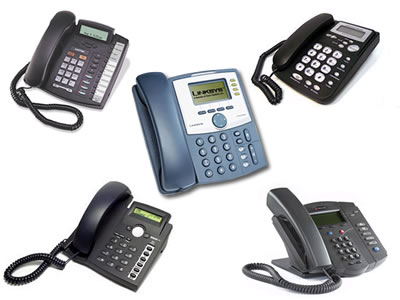SIP protocol VoIP phones

Although basic setup typically requires a minimum of four entries, these may need to be duplicated, re-parsed or the syntax changed, from one model of phone to another. For the moment, ease-of-setup is a major differentiator between models. Although it's possible to configure these phones from their keypads, it’s much easier to do using either a Web browser or a TFTP server.
Certainly remote setup, using configuration files, is the most attractive option for an IT department, allowing VoIP phone installations to be rolled out and maintained across an entire business from a central point.
Sadly, design values for VoIP phone seem a bit low on the agenda. Many are downright ugly and very few look like they hail from the 21st century. We selected five of the better-looking phones for this review.

On the features front, you get what you pay for. For example, entry-level phones often only support one VoIP account and don’t have a second switched Ethernet socket. The price of a phone that can handle up to four accounts is at least double that of a single-account phone. However, you get quite a range of user functionality even with the cheaper phones. Functions such as speakerphone, hold, transfer, conference, call switching and voicemail messaging support are almost universal. Although all these phones provide a means of interacting with a voicemail system, this is a service that has to be supported by the local server.
VoIP telephone performance cannot be assessed easily because the transmission path is likely to be different for every call. As a result, the quality of service (QoS) can vary in an uncontrolled fashion and is largely independent of the actual phone in use. However, test calls made from each of the five phones reviewed, to a local land-line phone, showed that -- at least under these simple and uncontrolled conditions -- call quality sounded identical.
What we found
Of the five VoIP phones reviewed here, the LinkSys SPA941 is probably the most attractive, while the Grandstream Budgetone 102 offers ease-of-use and a good range of functions at a low price and the Aastra 9133i provides direct access to many features with the largest number of buttons.
Overall, we recommend the £52.99 (ex. VAT) Grandstream Budgetone 102 for its ease of use and value for money, and the more costly LinkSys SPA 941 (£107.99 ex. VAT) for its good looks and ease of operation.
Evaluating VoIP equipment is complicated by the fact that there are so many possible features, protocols and standards that may, or may not, be supported. For example out of these five phones, two only specify support for the G.711 and G.729 protocols. Be aware that in corporate installations, support for certain features may make one particular phone a better fit for your specific application than others.
Our thanks to VoIP equipment and services distributor Telappliant (tel. 0845 004 4040), who supplied all the VoIP telephones for this review.